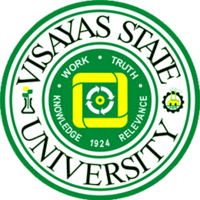Visayas State University
| Pamantasang Estado ng Kabisayaan | |
 | |
Former names | BAS, BNAS, VAC, ViSCA, LSU |
|---|---|
| Motto | RITE: Relevance, Integrity, Truth, and Excellence" |
| Type | Public |
| Established | August 1924 |
| President | Dr. Edgardo L. Tulin |
| Students | 7689 (as of 1st Sem SY 2014-2015) |
| Location |
|
| Campus | Rural |
| Hymn | VSU Hymn |
| Colors |
Gold Green |
| Nickname | VSUans, Viscans |
| Website |
www |
The Visayas State University is a premier university in the Philippines located at the city Baybay, Leyte, Philippines. It is one of the leading universities in Southeast Asia for research in agriculture. The five-campus VSU system has eight colleges, three institutes and one school. Located in the main campus are the College of Veterinary Medicine, College of Engineering, College of Education, College of Forestry and Environmental Science, College of Arts and Science, College of Nursing, College of Management and Economics,College of Agriculture and Food Sciences, Institute of Strategic Research and Development Studies, and the Graduate School and Special Programs.
Visayas State University is the only university in the Visayas acknowledged by the Philippine Department of Tourism as a tourist destination because of its diverse flora and fauna bounding the mainland and sea from side to side. With Mount Pangasugan and the Camotes Sea as VSU's backdrop, it makes the university distinctive from any other colleges and universities in the region. VSU administration is currently promoting the school as a "Resort University" for it has resorts, seafront suites, cottages, and bungalows catering to visitors and tourists coming over to the university.
The Main Campus has an Open University which takes care of the distance education program. Its external campuses which are located in the different parts of Leyte are the College of Fisheries (VSU-Tolosa Campus), College of Industrial Technology (VSU-Isabel Campus), College of Environmental and Agricultural Technology (VSU-Alangalang Campus), College of Education and Agricultural Technology (VSU-Villaba Campus).
It continues to specialize in agricultural research and education, including work in jatropha propagation for the production of biofuel and development of a dwarf macapuno coconut and root-crops, particularly, sweet potato, cassava and yam. The university also hosts a program on rain forestation, making VSU as the only school in the Visayas to be labeled as a "Dark Green School" by the Environmental Education Network of the Philippines.
Programs are available in Agro-Industry, Information Technology, Hospitality Management, Tropical Ecology, Veterinary Medicine, Forestry, Fishery, and Food Science and Technology.
The 1,099-hectare campus hosts 193 buildings composed of academic departments, research and trainings centers, staff and student housing facilities and other vital structures.
The University is home to faculty and academic staff obtaining most of their local and international recognitions in research and development, 92 of whom are Ph. D. degree holders, 110 MS degree holders and 72 BS degree holders from reputable colleges and universities here and abroad.
VSU and Mount Pangasugan
VSU is located by one of the last remaining rainforests in the Philippines. A study by Visayas State University (VSU) in Baybay City, Leyte [1] found many animal species listed by the World Conservation Union in the Red List of Threatened Animals (IUCN Red List), including the Philippine tarsier, Philippine flying fox, Fischer's pygmy fruit bat. New records of the microbat (Hipposideros obscurus), with a length of 5.5 centimeters and body weight of 10 grams, a type of skink (Tropidophorus grayi), and two new species of the Gobiidae fishes (Stiphodon olivaceus and Stiphodon surrufus) were also found by the VSU survey.
VSU’s Natural History Museum collected 43,000 arthropod specimens from 377 families and 500 genera on Mt. Pangasugan. A new species of orchid (Dendrobium milaniae) and a tiger beetle (Thopeutica milaniae) were named in honor of past VSU president Dr. Paciencia Po-Milan, a renowned ecologist.
Other endemic species include the eagle-owl, Philippine hawk-eagle, rufous-lored kingfisher, Philippine leafbird and miniature tit-babbler and flying lemur.
The Federal Republic of Germany (through the ViSCA-GTZ Applied Tropical EcologyProgranl, ViSCA, Baybay, Leyte, Philippines International) funded the VSU study to collect, identify, describe and document the existing species of aroids (Araceae) and orchids in Mt. Pangasugan. 25 species of aroids representing 12 genera were documented at elevations of up to 350 m ASL. Classified as erect ground dwellers or climbers, the most dominant aroid belong to Pothos and Epipremnum. The orchid species represent 16 genera, with the most dominant belonging to Phalaenopsis.[2]
The Herpetofauna (herps) of Anibong, Jordan, Mt. Pangasugan Range, Leyte is a habitat to endemic species, which is so diverse and slightly distributed. The Mindanao State University-Iligan Institute of Technology identified 17 herpetofaunal species belonging to 6 families (Ranidae, Rhacophoridae, Agamidae, Scincidae, Colubridae, Viperidae), of which eight (47%) are endemics (Endemism). These endemic species include Limnonectes magnus, Platymantis corrugatus, Platymantis dorsalis, Brachymeles samarensis, Draco lineatus, Sphenomorphus jagori, Rhabdophis lineata and Trimeresurus flavomaculatus. Limnonectes magnus is already in the near-threatened category.[3]
See also
References
Coordinates: 10°44′38″N 124°47′31″E / 10.744°N 124.792°E